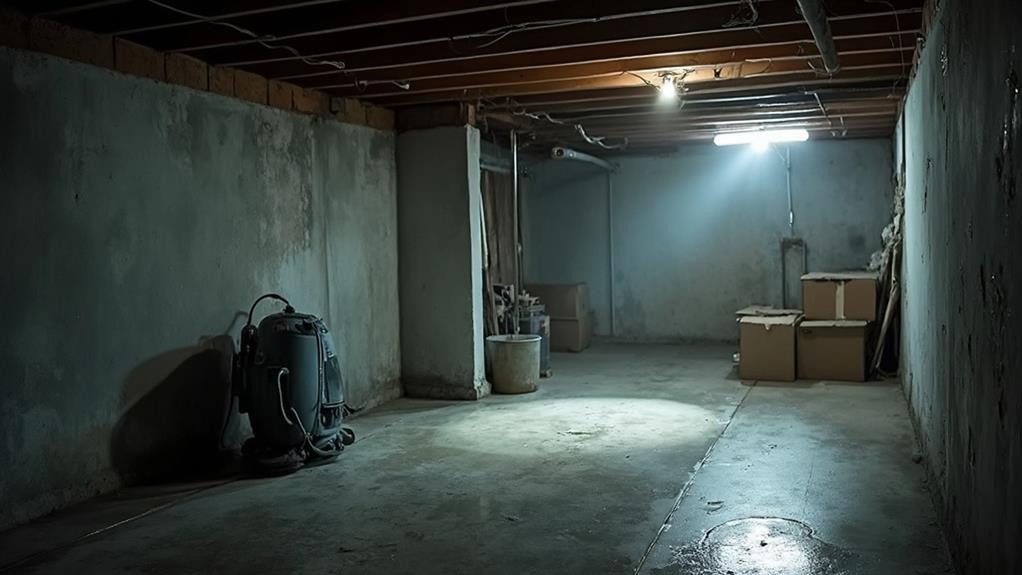To prevent mold growth in hidden areas after a flood, thorough inspection and moisture removal are crucial. Use moisture meters and infrared cameras to detect hidden pockets of dampness in walls, floors, and ceilings. Implement proper ventilation techniques, including fans and dehumidifiers, to reduce indoor humidity levels below 50%. Inspect and address moisture issues in crawl spaces, attics, and basements. Consider professional mold remediation services for comprehensive assessment and treatment. Long-term flood-proofing measures, such as improving drainage and sealing foundation cracks, can help prevent future issues. By addressing hidden moisture promptly and effectively, you can significantly reduce the risk of mold infestation in your home.
Identifying Hidden Moisture Pockets
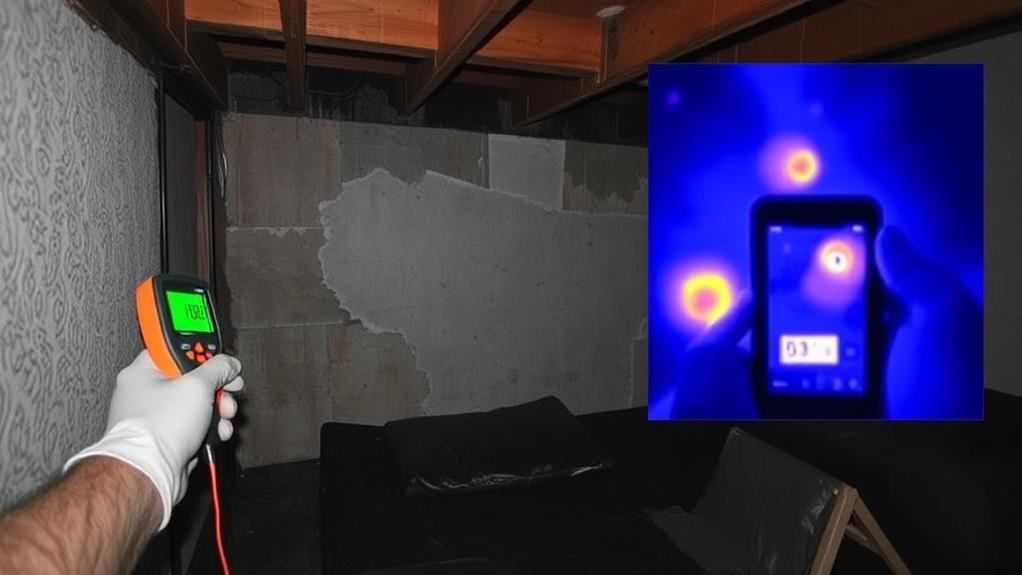
Detecting hidden moisture pockets is crucial in the aftermath of a flood to prevent mold growth. These concealed areas of dampness can harbor ideal conditions for mold spores to thrive, potentially leading to extensive damage and health hazards.
To identify these hidden pockets, start by thoroughly inspecting all surfaces, paying close attention to corners, crevices, and areas behind furniture or appliances.
Use moisture meters to detect elevated moisture levels in walls, floors, and ceilings. These devices can pinpoint areas of concern that may not be visible to the naked eye. Infrared cameras are another valuable tool, as they can reveal temperature differences that often indicate the presence of moisture. Don't overlook less obvious spaces like crawl spaces, attics, and the areas behind baseboards or under carpets.
Be vigilant for signs of water damage, such as discoloration, warping, or a musty odor. These indicators can lead you to hidden moisture pockets. Remember to check inside cabinets, closets, and other enclosed spaces where air circulation may be limited. By systematically identifying these problem areas, you can take targeted action to dry them thoroughly and prevent mold growth.
Proper Ventilation Techniques
Once hidden moisture pockets have been identified, implementing proper ventilation techniques is the next critical step in preventing mold growth after a flood. Effective ventilation helps remove excess moisture from the air and surfaces, creating an environment less conducive to mold growth.
Start by opening all windows and doors to allow for cross-ventilation. Use fans strategically to promote air circulation, positioning them to blow air out of windows and draw fresh air in from other openings. Dehumidifiers are essential in reducing indoor humidity levels, ideally maintaining them below 50%. Place dehumidifiers in the most affected areas and empty their reservoirs regularly.
For enclosed spaces like crawl spaces or attics, consider installing specialized ventilation systems such as exhaust fans or vents. These can help remove stagnant, moist air and replace it with drier outdoor air. In basements, use a combination of dehumidifiers and fans to circulate air and reduce moisture levels.
Remember to ventilate even on cooler days, as the goal is to remove moisture, not just lower temperatures. Continuously monitor humidity levels using hygrometers and adjust ventilation strategies accordingly to maintain an inhospitable environment for mold growth.
Dehumidification Strategies
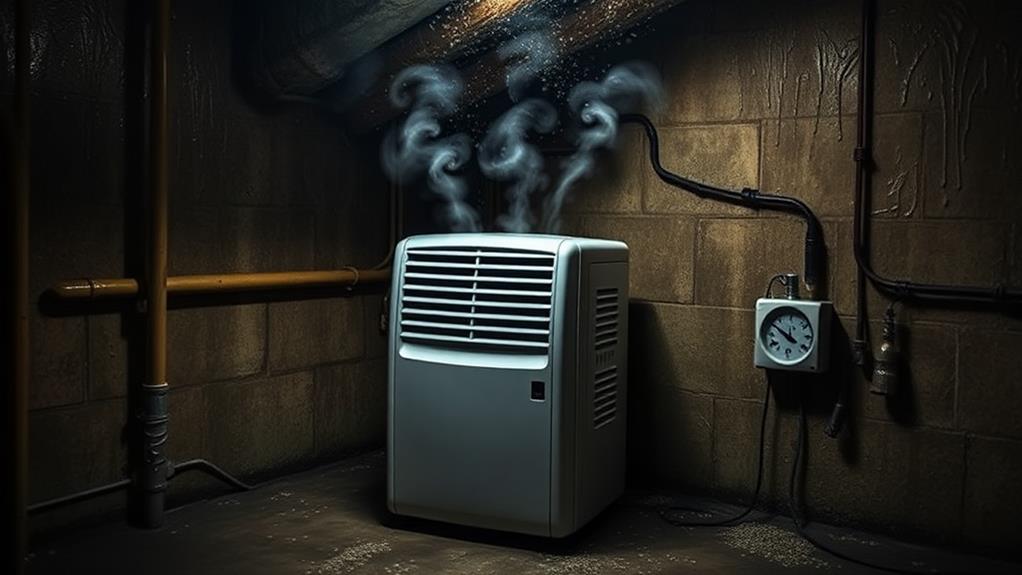
Effective dehumidification is crucial in the battle against mold growth after a flood. To reduce moisture levels in affected areas, employ a combination of industrial-grade dehumidifiers and portable units. Place dehumidifiers strategically throughout the space, focusing on areas with the highest humidity levels and poorest air circulation.
Monitor relative humidity levels using hygrometers, aiming to maintain them below 50% to inhibit mold growth. In larger spaces, consider using desiccant dehumidifiers, which are more effective at lower temperatures and can remove moisture from dense materials like wood and concrete.
Implement a systematic approach to dehumidification by dividing the affected area into zones. Start with the most severely impacted areas and gradually move to less affected spaces. Ensure proper drainage of collected water from dehumidifiers to prevent reintroduction of moisture into the environment.
Combine dehumidification with air movement techniques, such as using fans to improve circulation and promote evaporation. This synergistic approach accelerates the drying process and helps prevent moisture from becoming trapped in hidden areas. Regularly empty and clean dehumidifiers to maintain their efficiency and prevent them from becoming potential sources of mold growth themselves.
Wall Cavity Inspection Methods
Thorough wall cavity inspection is critical for identifying hidden moisture and potential mold growth after a flood. Several methods can be employed to assess the condition of wall cavities without causing extensive damage to the structure.
Non-invasive moisture meters are valuable tools for detecting moisture levels within walls. These devices use electromagnetic signals to measure moisture content without penetrating the surface. Infrared cameras can also be used to identify temperature variations that may indicate the presence of moisture.
For a more detailed examination, small inspection holes can be drilled into walls to visually inspect the interior and collect samples if necessary. Borescopes, which are small cameras attached to flexible tubes, can be inserted into these holes to provide a clear view of the wall cavity.
In some cases, partial removal of drywall or paneling may be required to fully assess the extent of moisture damage and potential mold growth. This method allows for direct visual inspection and facilitates thorough drying and cleaning of affected areas.
Professional mold inspectors may also use air sampling techniques to detect the presence of mold spores within wall cavities, providing valuable information about potential hidden growth.
Crawl Space Mold Prevention
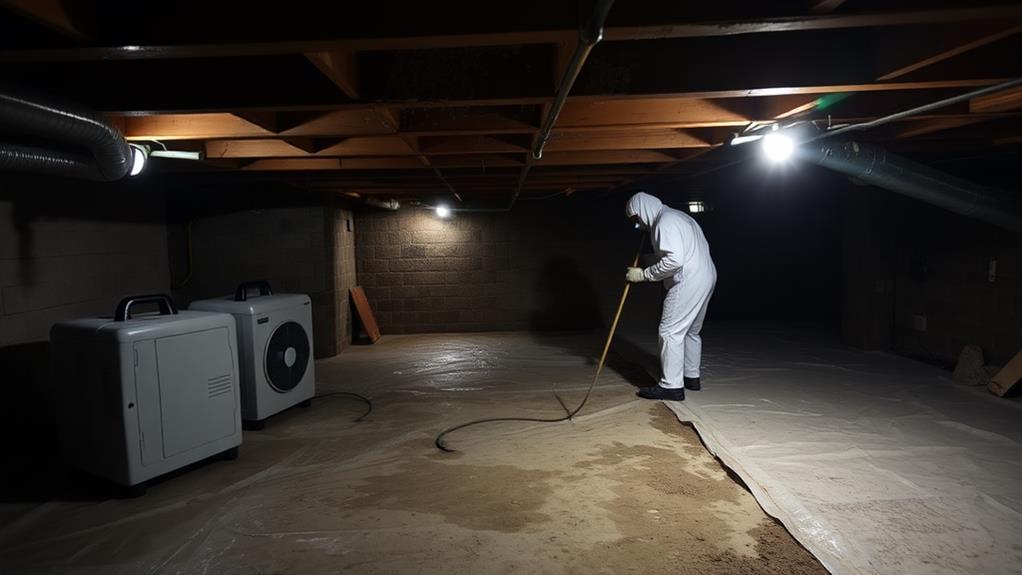
Crawl spaces are particularly vulnerable to mold growth after flooding due to their low-lying position and often poor ventilation. To prevent mold growth in these areas, it's crucial to act quickly and implement effective preventive measures.
First, remove all standing water from the crawl space using pumps or wet vacuums. Once the water is removed, thoroughly dry the area using dehumidifiers and fans to circulate air. Install a vapor barrier on the ground to prevent moisture from seeping up from the soil.
Inspect and repair any damaged insulation, removing wet materials that cannot be salvaged. Ensure proper ventilation by installing vents or a dehumidification system to maintain optimal humidity levels. Consider encapsulating the crawl space to create a controlled environment that resists moisture intrusion.
Regular inspections are essential to catch any signs of mold growth early. Use mold-resistant materials when replacing damaged components, and apply fungicidal coatings to surfaces to inhibit future mold growth. Additionally, address any external factors contributing to moisture accumulation, such as improper grading or faulty gutters, to prevent future flooding and mold issues in the crawl space.
Attic Moisture Control
Vigilance in attic moisture control is crucial for preventing mold growth after a flood. Attics are particularly vulnerable to moisture accumulation due to their location and often limited ventilation. To combat this, ensure proper insulation and ventilation are in place.
Install soffit vents and ridge vents to promote air circulation, which helps regulate temperature and humidity levels.
Regularly inspect your attic for signs of water infiltration, such as stains on the underside of the roof decking or insulation. Address any roof leaks promptly to prevent moisture from seeping into the attic space. Consider installing a vapor barrier on the attic floor to minimize moisture transfer from living spaces below.
Monitor attic humidity levels using a hygrometer, aiming to maintain levels below 60%. If necessary, use a dehumidifier to reduce excess moisture. After a flood, remove any wet insulation or materials immediately and thoroughly dry the area. Install attic fans or powered ventilators to enhance air circulation and moisture removal.
Trim overhanging tree branches to allow more sunlight to reach the roof, helping to dry out any moisture. By implementing these measures, you can significantly reduce the risk of mold growth in your attic following flood events.
Basement Waterproofing Tips
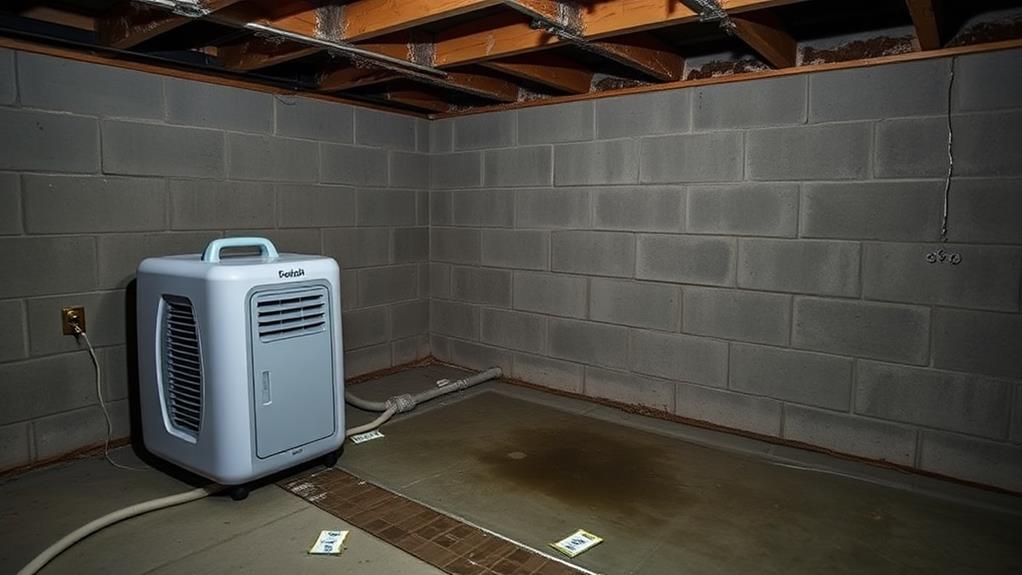
Resilience against water intrusion is paramount when it comes to basement waterproofing. To effectively protect your basement from moisture and potential mold growth, implement a multi-faceted approach. Begin by inspecting the exterior foundation for cracks or gaps, sealing them with hydraulic cement or epoxy injections. Install a robust drainage system, including French drains and a sump pump, to redirect water away from the foundation.
Apply a waterproof sealant to interior basement walls and floors, creating a barrier against moisture penetration. Ensure proper grading around the house, sloping the ground away from the foundation to prevent water accumulation. Install gutters and downspouts that extend at least five feet from the house to channel rainwater effectively.
Consider installing a dehumidifier to maintain optimal humidity levels in the basement, typically between 30-50%. Regularly clean and maintain gutters, downspouts, and drainage systems to prevent clogs and ensure efficient water diversion. For added protection, apply a water-resistant coating to exterior foundation walls and install a vapor barrier beneath the basement floor during construction or renovation. These comprehensive measures will significantly reduce the risk of water intrusion and subsequent mold growth in your basement.
Professional Mold Remediation Services
When facing extensive mold growth following a flood, professional mold remediation services become essential for thorough and safe removal. These experts possess the knowledge, equipment, and experience to effectively address mold infestations in hidden areas that may be overlooked by inexperienced individuals.
Professional remediation services typically begin with a comprehensive assessment of the affected areas, including moisture testing and mold identification. They then develop a tailored remediation plan, which often involves containment measures to prevent mold spores from spreading to unaffected areas.
Using specialized equipment such as HEPA air filtration devices and negative air pressure systems, they create a controlled environment for mold removal. The remediation process usually includes removing contaminated materials, cleaning salvageable items, and applying antimicrobial treatments to prevent future growth.
Professionals also address the underlying moisture issues that led to mold growth, ensuring a long-term solution. After remediation, they conduct post-treatment testing to verify the effectiveness of their work.
Hiring certified mold remediation specialists not only ensures thorough removal but also provides documentation that may be required for insurance claims or property transactions. This professional approach significantly reduces the risk of recurring mold problems and protects occupants' health.
Long-Term Flood Proofing Measures
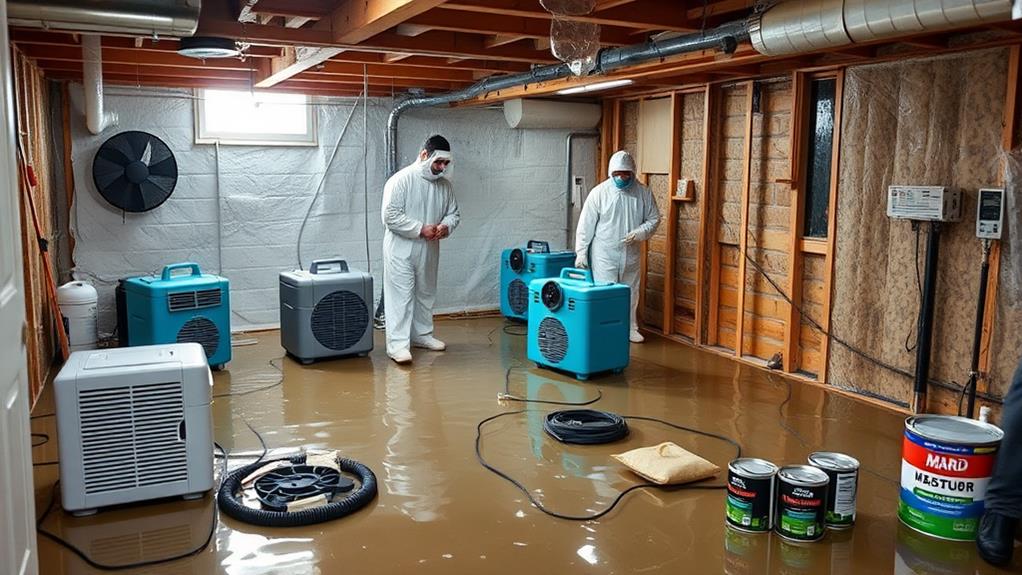
Beyond immediate post-flood cleanup and mold remediation, implementing long-term flood proofing measures is crucial for protecting properties against future water damage and mold growth. These preventive strategies can significantly reduce the risk of water intrusion and subsequent mold issues.
First, consider elevating critical systems and appliances, such as electrical panels, HVAC units, and water heaters, above potential flood levels. Install backflow valves on sewer and septic tank lines to prevent sewage backup during floods. Improve drainage around the property by grading the landscape away from the building and installing proper gutters and downspouts.
Seal foundation cracks and apply waterproof coatings to exterior walls to minimize water penetration. Install flood barriers or gates for doorways and windows in flood-prone areas. Consider using water-resistant building materials for floors, walls, and insulation in basements and lower levels.
Regularly maintain and clean gutters, downspouts, and storm drains to ensure proper water flow. Implement a sump pump system with a battery backup to remove excess water from basements or crawl spaces. Finally, review and update your flood insurance coverage to ensure adequate protection against potential losses.
Frequently Asked Questions
How Long After a Flood Does Mold Typically Start Growing?
Mold typically begins to grow within 24 to 48 hours after water exposure. However, visible growth may not appear for several days. Factors like temperature, humidity, and the type of surface can influence the speed of mold development.
Can Mold Growth Be Prevented if Items Are Dried Within 24 Hours?
Drying items within 24 hours can significantly reduce the risk of mold growth. However, complete prevention is not guaranteed, as some mold spores may begin germinating earlier. Thorough cleaning and dehumidification are also crucial for effective prevention.
Are There Specific Paint Types That Can Inhibit Mold Growth on Walls?
Like a shield against an unseen enemy, mold-resistant paints can indeed inhibit fungal growth on walls. These specialized coatings contain antimicrobial agents that create an inhospitable environment for mold spores, offering long-lasting protection for interior surfaces.
What Are Signs of Hidden Mold Growth Besides Visible Mold or Odors?
Signs of hidden mold growth can include unexplained respiratory issues, allergic reactions, or skin irritation. Water stains, discoloration, or bubbling on walls and ceilings may indicate moisture problems. Persistent dampness or humidity can also suggest potential mold issues.
How Often Should Mold Inspections Be Conducted After a Flood Remediation Process?
Mold inspections should be conducted immediately after flood remediation, then monthly for the first quarter. Subsequently, quarterly inspections are recommended for the first year. After that, annual inspections suffice, unless moisture issues or concerning symptoms arise.
Conclusion
In the aftermath of a flood, vigilance against hidden mold growth is paramount. Like an unseen enemy lurking in the shadows, moisture can harbor dangerous spores in concealed spaces. By implementing comprehensive moisture detection, ventilation, dehumidification, and waterproofing strategies, homeowners can fortify their dwellings against mold's insidious advance. Regular inspections of wall cavities, crawl spaces, attics, and basements, coupled with professional remediation when necessary, form a robust defense. Ultimately, long-term flood-proofing measures serve as the foundation for a mold-resistant, healthier living environment.
